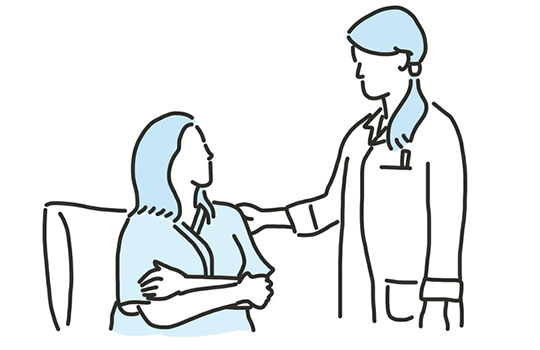An excellent patient-doctor relationship is capable of doing much good, even when medicine no longer can
 We learn at an early age that percentages matter in our lives. From school throughout adulthood, they figure prominently. Our grades, interest rates, and tax brackets are measurable indicators of the world we live in. Pharmaceutical companies tout them for efficacy and side effects, doctors quote them to reassure or forewarn patients. In my experience, one of the most dramatic ways these ratios influence my life is the ever enigmatic placebo effect, that confounding 30% that I have been fortunate enough to find in the healthcare professionals around me. Longer lasting and more durable than sugar pills or saline solutions is the elixir of the relationships I have formed.
We learn at an early age that percentages matter in our lives. From school throughout adulthood, they figure prominently. Our grades, interest rates, and tax brackets are measurable indicators of the world we live in. Pharmaceutical companies tout them for efficacy and side effects, doctors quote them to reassure or forewarn patients. In my experience, one of the most dramatic ways these ratios influence my life is the ever enigmatic placebo effect, that confounding 30% that I have been fortunate enough to find in the healthcare professionals around me. Longer lasting and more durable than sugar pills or saline solutions is the elixir of the relationships I have formed.
I am but one of many patients to use the ever revolving door to a medical professional’s office; one of the many faces and bodies to fill the chair by the desk, a puzzle to solve, another part of a busy practice. Someone, and something, to close the office door on at the end of a long day. Depending on the length of time allocated to every patient, I may be one of as many as six in an hour or as few as two. To a busy clinician, time spent with me is one part of a thriving practice. It is relatively meaningless, and even less so to a doctor I don’t know. The reverse, however, is not necessarily true.
Patients anticipate appointments and often reflect on them and their outcome—they are not always easily forgotten, especially when they are infrequent. While I see some of my specialists more often than others, each visit has significance. It also has to carry me through to the next one—physically, mentally, and emotionally. (Months can drag on to feel like years.) Even though my doctors are booked up well in advance, I have the comfort of knowing that if my need is urgent, I will somehow be seen earlier.
An excellent patient-doctor relationship is capable of doing much good, even when medicine no longer can. My strength and determination are, after all, two psychological beasts that do occasionally need feeding and nurturing. A strong bond helps to shore up a patient during the difficult periods. An annual or quarterly visit needs to have lasting impact. One half hour visit is the equivalent of 0.00570776% of a year. Imagine the magnitude necessary to turn it into 30%. Now imagine that you have that power.
Doctors are in a position to sting or support like few other professionals can, being privy to intimate details and personal history, and knowing things that often aren’t shared with others. A good friend once experienced the cut of a doctor’s sharp tongued comment relating to her bipolar disease, which was followed by a curt dismissal. She was hurt and left in a state of disbelief. On the other hand, I have had the incredible relief of hearing the words “I believe you,” as well as the empowering “I believe we can lessen your pain with exercise.” Belief is key—but not just for patients. Doctors need to believe that they themselves can sometimes be a placebo and influence a patient’s life.
Surprisingly, it is possible to begin building that power in the waiting room. Those usually dark and dated rooms, which so quickly extinguish any levity or humour, can give rise to anger, fear, and despair. (Any laughter there is usually met with a glance from others as if to say “don’t you know we are sick?”) When my doctors come to meet me and show me in, their greeting and broad, sincere smile brightens any room to me. No amount of expensive decor could best that feeling.
One particular visit to one of my specialists underscored the dynamic effect a doctor can have on a waiting room. Walking through the seating area, she was obviously in good humour and seemed genuinely happy to be there working. Behind us, light, friendly banter between the staff was audible. As the rain lashed the skylight, patients began talking about the weather warning issued earlier—a rarity for a place usually reserved for negativity and silence.
A few weeks later, I walked through the same waiting room after closing hours—this time bereft of staff and patients. Not long before it had been full of cheerful voices, and even though the sun shone through the skylight, that day it looked just as dreary as the many other times I have been inside. It wasn’t my imagination, it was the doctor who set the tone.
The placebo effect is most often associated with fake medication or even, rather drastically, sham surgery. It’s smoke and mirrors—but the benefits of a good patient-doctor relationship are no illusion.
I have a rapport with my specialists that I value and that is invaluable. The power of a patient-doctor connection should not be underestimated. Donning white coats or prescribing sugar pills is not necessary, and while a good connection is not a cure, it is a balm. I can assure you from personal experience that it is worth the effort. I have a list of medications that is sizable. I carry a copy in my wallet that often saves time and avoids mistakes when I am seeing a new doctor or other medical professionals. When I travel, the containers and bottles are numerous enough to fill a small carry bag. They are cumbersome and heavy, both physically and mentally, but it is a weight made remarkably lighter by my relationships with my doctors.
Mutual trust and respect, happiness, a warm smile, a touch of the arm, or a handshake coupled with sincerity—and yes, even a touch of humour—help make for an uplifting appointment when you live with a chronic disease. My relationships with my doctors and my healthcare team—it’s the best medication that I have never taken.
Sharon Roman studied economics at the University of Toronto and Simon Fraser University. She had her first MS attack around the age of 30. Twitter @SRoman_SPQR
Competing interests: None declared.
